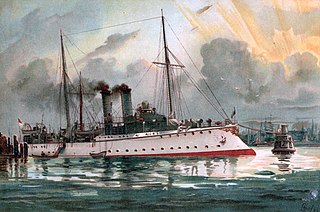
The German East Asia Squadron was an Imperial German Navy cruiser squadron which operated mainly in the Pacific Ocean between the mid-1890s until 1914, when it was destroyed at the Battle of the Falkland Islands. It was based at Germany's Jiaozhou Bay Leased Territory in China.
SMS Kaiser has been the name of two ships of the German Imperial Navy:

SMS Eber was the last of the six gunboats of the Iltis class of the German Imperial Navy prior to and during World War I. Other ships of the class are SMS Iltis, SMS Luchs, SMS Tiger, SMS Jaguar and SMS Panther. They were built between 1898 and 1903. All of them served primarily overseas, in the German colonies. Eber had a crew of 9 officers and 121 men.

Kaiserliche Werft Wilhelmshaven was a German shipbuilding company in Wilhelmshaven, founded in 1871 and closed in 1918. Together with Kaiserliche Werft Danzig and Kaiserliche Werft Kiel it was one of three shipyards which solely produced warships for the Preußische Marine and the following German Kaiserliche Marine. With the end of World War I all three imperial shipyards were closed, but the Wilhelmshaven shipyard was reopened in 1919, first as Reichsmarinewerft Wilhelmshaven, and after 1935 named Kriegsmarinewerft Wilhelmshaven.

The QF 3-pounder Hotchkiss or in French use Canon Hotchkiss à tir rapide de 47 mm were a family of long-lived light 47 mm naval guns introduced in 1886 to defend against new, small and fast vessels such as torpedo boats and later submarines. There were many variants produced, often under license, which ranged in length from 32 to 50 calibers but 40 caliber was the most common version. They were widely used by the navies of a number of nations and often used by both sides in a conflict. They were also used ashore as coastal defense guns and later as an anti-aircraft gun, whether on improvised or specialized HA/LA mounts.
SMS Prinz Eitel Friedrich may refer to:
Two ships of the Imperial German Navy, and one of the Prussian Navy, have borne the name SMS Vineta, named after the mythic city of Vineta :

The German commerce raiders of World War I were surface vessels used by the Imperial German Navy for its Handelskrieg, a campaign against Allied seaborne trade. The ships comprised warships, principally cruisers, stationed in the German colonial empire before the war began, express liners commissioned as auxiliary cruisers and later, freighters outfitted as merchant raiders. These vessels had a number of successes and had a significant effect on Allied naval strategy, particularly in the early months of the war.
Several naval ships of Germany were named Bremse after the horse-fly :
Several naval ships of Germany were named Brummer after the blow-fly:
Several naval ships of Germany were named Danzig after the city of Danzig, modern-day Gdansk, Poland.

SMS Iltis was the lead ship of the Iltis class of gunboats built for the German Kaiserliche Marine in the late 1890s and early 1900s. Other ships of the class are SMS Luchs, SMS Tiger, SMS Eber, SMS Jaguar, and SMS Panther.

SMS Jaguar was the second member of the Iltis class of gunboats built for the German Kaiserliche Marine in the late 1890s and early 1900s, for overseas service in the German colonial empire. Other ships of the class are SMS Iltis, SMS Luchs, SMS Tiger, SMS Eber and SMS Panther.

SMS Luchs was the fourth member of the Iltis class of gunboats built for the German Kaiserliche Marine in the late 1890s and early 1900s. Other ships of the class are SMS Iltis, SMS Tiger, SMS Eber, SMS Jaguar and SMS Panther.

SMS Tiger was the third member of the Iltis class of gunboats built for the German Kaiserliche Marine in the late 1890s and early 1900s. Other ships of the class were SMS Iltis, SMS Luchs, SMS Eber, SMS Jaguar and SMS Panther.
Several ships of the German and Austro-Hungarian Navies have been named SMS Greif
Several ships in the Prussian Navy and later German Imperial Navy and the Austro-Hungarian Navy have been named SMS Tiger:
At least three ships of the Prussian Navy or Austro-Hungarian Navy had been named SMS Sperber:
At least three ships of the Prussian Navy or Austro-Hungarian Navy had been named SMS Schwalbe:
This page is based on this
Wikipedia article Text is available under the
CC BY-SA 4.0 license; additional terms may apply.
Images, videos and audio are available under their respective licenses.








